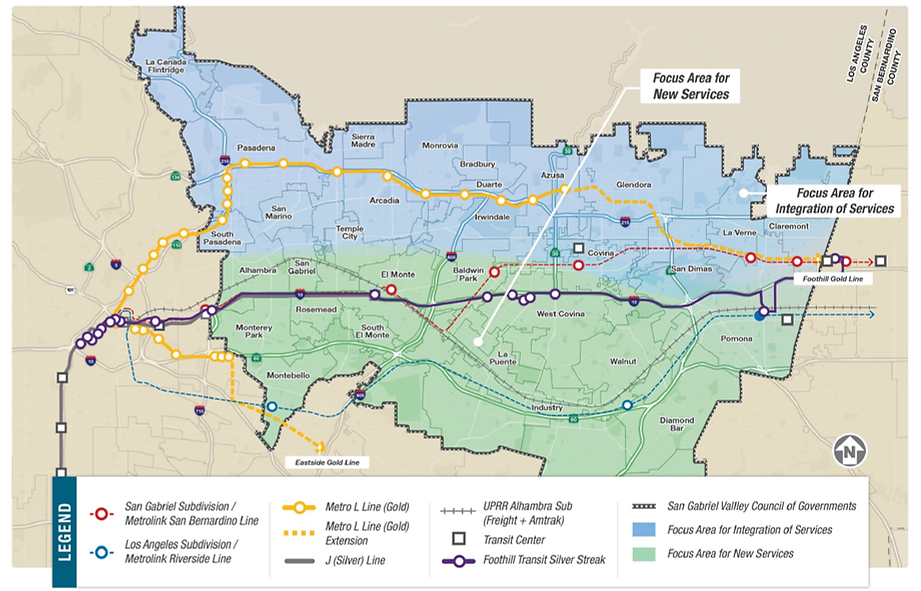 View Winners →
View Winners → San Gabriel Valley Council of Governments seeks community feedback on transit project

On Sept. 20, the San Gabriel Valley Council of Governments, in partnership with Los Angeles Metro, hosted a public workshop on the latest progress of the San Gabriel Valley Transit Feasibility Study. The study is a effort to Identify feasible transit solutions running east of Los Angeles proper. This workshop included a presentation of three short- and long-term transit options designed to enhance travel for communities and the lives of residents, commuters and visitors. Participants provided feedback and asked questions on the options for further consideration.
“We’re still really early in this phase, and we are going to be working directly with the cities that are along these corridors to ensure that their concerns (are heard), so we get the buy-in and feedback from them as well. So this is going to be a team effort between us, communities and cities. And then see how we can kind of work together to refine these (options) and make this a project that everybody will be happy with,”said Ricky Choi, director of government and community relations at SGVCOG.
The goal of this study that covers all 31 cities and the unincorporated communities within the San Gabriel Valley Council of Governments service area is to hone in on the best transit plan to use the $635.5 million in local sales tax measure (Measure R) funds available for the near-term (15 years) improvements, with long-term (2053) improvements subject to further funding availability.
None of the options include a rail system because of the high cost associated with rail projects. Bus Rapid Transit systems cost $10 million per mile on the low end up to more than $100 million per mile on the highest end. Additionally, these routes have sections with dedicated bus lanes to streamline travel. The bus lanes can be constructed center-running ($6 million per mile), side-running ($1.5 million per mile), and/or curb-running ($3 million per mile).
Concept 1: Downtown LA to downtown Pomona via Valley Boulevard (estimated cost: $445 million)
Begins at LA union station, and follows Valley Boulevard to Grand Avenue. From there it will head north toward Mt. San Antonio College and Cal Poly Pomona. It then follows Holt to end in Pomona.
Concept 5: Atlantic Station to Downtown Pomona via Valley Boulevard & Colima/Golden Springs
Begins in Atlantic station, and follows Garvey to Valley Boulevard onto Mission Boulevard to end in Pomona. (estimated cost: $400 million)
Concept 2: Atlantic Station to Downtown Pomona via SR-60
Also begins in Atlantic station but takes the freeway (SR-60) and follows Mission Boulevard to end in Pomona. (Estimated cost: n/a)
“The key feature is that we have limited stops and we have frequent service and we have frequent service all day long in both directions. The buses themselves would be zero emission buses, we would have some segments for dedicated right of way (and) transit signal priority,” said Brett Ogden, the project manager for the technical consultant team, during the presentation, “We would have enhanced stations compared to the typical bus shelter and there would be bus arrival information and we would make other improvements to make these stations accessible and convenient.”
“If you look at the numbers on the bottom, which gives the boardings and the transit trips, you can see that concept one is by far the most attractive service of the three and that concept two is the least attractive service of the three and then has that five fall somewhere in the middle … Based upon the ridership estimate of these three services we’re not recommending, we’re basically dropping, that concept two at this point in time and continuing to look further at C-1and C-5,¨ said Ogden.
Additionally, there were four north-south options presented. All the routes were parsed down from an original 15 and can be chosen singularly or in combination, depending on the public needs.
“We’re going to be having a long-range vision plan that will sort of sell the ultimate transit vision for San Gabriel Valley,” Ogden added, “In that vision plan. There’ll be an integrated network with enhanced connectivity and accessibility to services. And then there’ll be an implementation of roadmaps and phases of development, how this might be flown over time.”
The SGVCOG will be collaborating with constituents so that a finalized plan may be presented to Metro for approval.
“On a moving forward basis we will be drilling down and taking these concepts and seeing where they actually fit in each city that’s along the different route segments,” Ogden said.
To find the dates of future workshops, visit https://www.sgvcog.org/transit-study-community-input. A public input form can also be found via the same link. SGVCOG can also be found on Instagram, Facebook and Twitter.









































































































